Making high tech medical gels with Australian spinifex grass
From nanotechnology to Indigenous empowerment
A new company, Trioda Wilingi, has announced that they plan to develop innovative medical gels from cellulose nanofibres extracted from spinifex grass harvested in north-west Queensland.
The company is majority owned by Indigenous Australians and will commercialise patented technology developed with the help of ANFF-Q’s University of Queensland Hub. Uniseed and Bulugudu Ltd, the traditional owners of this knowledge, will invest $2.6 million in the company.
The company is one of the first to spin out with the support of ANFF-C, our new commercialisation arm.
Funded by the Australian government through NCRIS, the National Collaborative Research Infrastructure Strategy, ANFF-C’s purpose is to help ANFF-facilitated technology start the journey to market by removing some of the barriers that fledgling companies face in translating innovative technology to real-world products.

Spinifex is a family of extremely durable grasses that can survive drought, controlled burning and bush fires. They grow widely across Outback Australia. Trioda Wilingi’s cellulose nanofibers are extracted from the variant Triodia pungens.
“Indjalandji-Dhidhanu people have long known of the uses and the strength of spinifex grass,” says Colin Saltmere AM, Director of Bulugudu Ltd, a company owned by the Indjalandji-Dhidhanu people, the Traditional Owners of the upper Georgina River region.
In 2008, the Dugalunji Aboriginal Corporation (now Bulugudu Ltd) and The University of Queensland were awarded an Australian Research Council Discovery Grant to explore the Aboriginal and Western scientific knowledge of spinifex grasses. Leveraging the traditional knowledge of the Indjalandji-Dhidhanu, the project investigated the use of spinifex as a source of cellulose reinforcing agents.
The University of Queensland, through the Australian Institute for Bioengineering and Nanotechnology (AIBN), discovered that spinifex has a unique chemistry that yields strong, long, thin, and flexible nanofibres that could be extracted using a gentle, environmentally low-impact nanotechnology processing method. This combination of properties makes this source of nanocellulose fibres very attractive for commercial applications.
The late Dr Ian Griffiths, the previous ANFF CEO, recognised the potential of the fibres in medical gels and started the commercialisation negotiations that led to the establishment of Trioda Wilingi and this investment.
The unique properties of the spinifex fibres can produce gels that can hold plenty of water (needed for medical applications) while also being able to flow through a fine needle without resistance.“We’ve integrated traditional knowledge of the plant and how it grows with cutting-edge nanotechnology to create the beginnings of a new industry,” says Tim Case, interim CEO of Trioda Wilingi. “We anticipate that these medical gels will have many potential applications including osteoarthritis, drug delivery and cosmetic treatments.”
The development of spinifex fibres as a commercial product will also lead to jobs in a high-tech industry, with flow-on effects creating more opportunities for Indigenous people to engage in STEM education. A portion of any future royalty stream will be allocated to an Indigenous education fund that aims to maximise training, education, and network opportunities for Indigenous Australians.
And the Traditional Owners will have an ongoing role in the harvesting and early-stage processing of the grass, creating jobs at Camooweal and other remote communities in northern Australia.
“This project is a clear example of the type of impact ANFF can have on the conversion of research into real-world products. We are so proud to have helped this work spin out into Trioda Wilingi, which will have positive influence in varied sectors,” says ANFF CEO Dr Jane Fitzpatrick.
To read the full media statement on the Trioda Wilingi investment launch, click here.
